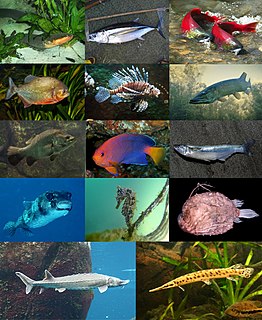
Actinopterygii, members of which are known as ray-finned fishes, is a clade of the bony fishes. They comprise over 50% of living vertebrate species.
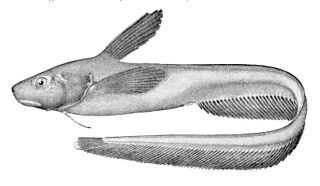
The jellynose fishes or tadpole fishes are the small order Ateleopodiformes. This group of ray-finned fish is monotypic, containing a single family Ateleopodidae. It has about a dozen species in four genera, but these enigmatic fishes are in need of taxonomic revision.

Cirrhitidae, the hawkfishes, are a family of marine perciform ray-finned fishes found in tropical seas and which are associated with coral reefs.

Fish locomotion is the variety of types of animal locomotion used by fish, principally by swimming. This is achieved in different groups of fish by a variety of mechanisms of propulsion in water, most often by wavelike movements of the fish's body and tail, and in various specialised fish by movements of the fins. The major forms of locomotion in fish are anguilliform, in which a wave passes evenly along a long slender body; sub-carangiform, in which the wave increases quickly in amplitude towards the tail; carangiform, in which the wave is concentrated near the tail, which oscillates rapidly; thunniform, rapid swimming with a large powerful crescent-shaped tail; and ostraciiform, with almost no oscillation except of the tail fin. More specialised fish include movement by pectoral fins with a mainly stiff body, opposed sculling with dorsal and anal fins, as in the sunfish; and movement by propagating a wave along the long fins with a motionless body in fish with electric organs, as in the knifefish.

Rajiformes is one of the four orders in the superorder Batoidea, flattened cartilaginous fishes related to sharks. Rajiforms are distinguished by the presence of greatly enlarged pectoral fins, which reach as far forward as the sides of the head, with a generally flattened body. The undulatory pectoral fin motion diagnostic to this taxon is known as rajiform locomotion. The eyes and spiracles are located on the upper surface of the head and the gill slits are on the underside of the body. Most species give birth to live young, although some lay eggs enclosed in a horny capsule {{Citation needed}}.

The Urolophidae are a family of rays in the order Myliobatiformes, commonly known as stingarees or round stingrays. This family formerly included the genera Urobatis and Urotrygon of the Americas, which are presently recognized as forming their own family Urotrygonidae. Stingarees are found in the Indo-Pacific region, with the greatest diversity off Australia. They are sluggish, bottom-dwelling fish that have been recorded from shallow waters close to shore to deep waters over the upper continental slope. Measuring between 15 and 80 cm long, these rays have oval to diamond-shaped pectoral fin discs and relatively short tails that terminate in leaf-shaped caudal fins, and may also have small dorsal fins and lateral skin folds. Most are smooth-skinned, and some have ornate dorsal color patterns.

Acanthopterygii is a superorder of bony fishes in the class Actinopterygii. Members of this superorder are sometimes called ray-finned fishes for the characteristic sharp, bony rays in their fins; however this name is often given to the class Actinopterygii as a whole.

The spadenose shark is a species of requiem shark in the family Carcharhinidae. It is common in the tropical Indian and western Pacific Oceans, where it forms large schools in shallow water. A small shark reaching a length of 74 cm (29 in), the spadenose shark is named for its distinctively flattened, triangular snout. It is a predator of small bony fishes and invertebrates. This species exhibits the most advanced mode of viviparity of any fish, in which the developed embryos form a highly complex placental connection to the mother at a very small size. Females breed year-round, giving birth to six to 18 pups after a gestation period of 5–6 months. The spadenose shark is harmless to humans and is valued by artisanal and commercial fishers for its meat and fins. Its abundance ensures it forms a significant component of many fisheries in South and Southeast Asia. The International Union for Conservation of Nature has assessed this species as Near threatened. This fish is also known as mori in Goa

The spot-tail shark, or sorrah shark, is a species of requiem shark, in the family Carcharhinidae, found in the tropical Indo-West Pacific Ocean between latitudes 31°N and 31°S, from the surface to a depth around 72 m (236 ft). This shark grows to about 1.6 m. It is fished commercially over much of its range and the IUCN considers it to be near threatened.
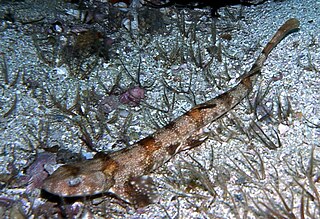
Haploblepharus is a genus of catshark, and part of the family Scyliorhinidae, containing four species of shysharks. Their common name comes from a distinctive defensive behavior in which the shark curls into a circle and covers its eyes with its tail. The genus is endemic to southern Africa, inhabiting shallow coastal waters. All four species are small, stout-bodied sharks with broad, flattened heads and rounded snouts. They are characterized by very large nostrils with enlarged, triangular flaps of skin that reach the mouth, and deep grooves between the nostrils and the mouth. Shysharks are bottom-dwelling predators of bony fishes and invertebrates. They are oviparous, with the females laying egg capsules. These harmless sharks are of no commercial or recreational interest, though their highly limited distributions in heavily fished South African waters are of potential conservation concern.

The banded houndshark is a species of houndshark in the family Triakidae, common in the northwestern Pacific Ocean from the southern Russian Far East to Taiwan. Found on or near the bottom, it favors shallow coastal habitats with sandy or vegetated bottoms, and also enters brackish water. This shark reaches 1.5 m (4.9 ft) in length. It has a short, rounded snout and mostly narrow fins; the pectoral fins are broad and triangular, and the trailing margin of the first dorsal fin is almost vertical. It is gray above and lighter below; younger sharks have darker saddles and dots, which fade with age.

Scardinius is a genus of ray-finned fish in the family Cyprinidae commonly called rudds. Locally, the name "rudd" without any further qualifiers is also used for individual species, particularly the common rudd. The rudd can be distinguished from the very similar roach by way of the rudd's upturned mouth, allowing it to pick food items such as aquatic insects from the surface of the water with minimal disturbance.
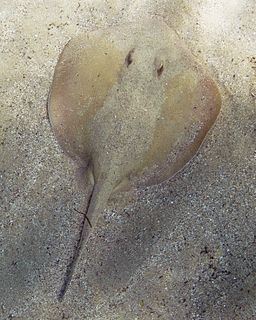
The common stingaree is a species of stingray in the family Urolophidae. The most abundant ray in inshore waters off eastern Australia, it generally inhabits estuaries, sandy flats, and rocky reefs from the shore to a depth of 60 m (200 ft). This plain brownish to grayish species has a rounded pectoral fin disc with a broadly triangular snout. Its nostrils have enlarged lobes on their outer margins and a skirt-shaped curtain of skin with a fringed posterior margin between them. Its tail bears a small dorsal fin before the stinging spine, and terminates in a leaf-shaped caudal fin. This ray can grow to 52 cm (20 in) long.

The crossback stingaree or banded stingaree is a species of stingray in the family Urolophidae. It is endemic to southeastern Australia, mainly off Victoria and Tasmania but also marginally to New South Wales and South Australia. This bottom-dwelling fish generally inhabits sand and reef habitats deeper than 100 m (330 ft) off Victoria, and muddy habitats in shallow bays and estuaries off Tasmania. Befitting its name, the crossback stingaree has a distinctive dark pattern on its back, consisting of a midline stripe that is crossed by three transverse bars. It has an oval pectoral fin disc with a blunt snout and a skirt-shaped curtain of skin between the nostrils. Its tail is short with no skin fold along the sides, and a deep, leaf-shaped caudal fin. The youngest rays may have a small dorsal fin in front of the stinging tail spine. This species reaches 50 cm (20 in) in length.

The whiptail stingrays are a family, the Dasyatidae, of rays in the order Myliobatiformes. They are found worldwide in tropical to temperate marine waters, and a number of species have also penetrated into fresh water in Africa, Asia, and Australia. Members of this family have flattened pectoral fin discs that range from oval to diamond-like in shape. Their common name comes from their whip-like tails, which are much longer than the disc and lack dorsal and caudal fins. All whiptail stingrays, except the porcupine ray, have one or more venomous stings near the base of the tail, which is used in defense. They range in size from 0.18 to 2.0 m or more across.

Lepidoperca is a small genus of fish belonging to the Anthiinae subfamily. It includes ten species.

Pristipomoides is a genus of marine ray-finned fish belonging to the family Lutjanidae, the snappers. They are found in the Atlantic, Indian and Pacific oceans.
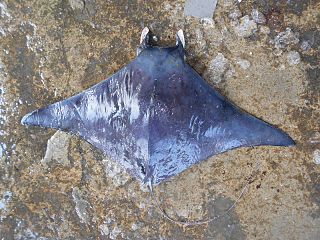
Mobula kuhlii, the shortfin devil ray, is a species of ray in the family Mobulidae. It is endemic to the Indian Ocean and central-west Pacific Ocean. It ranges from South Africa, Mozambique, Tanzania and the Seychelles in the west to the Philippines and Indonesia in the east, and southward to the northern coast of Australia.

Pseudochrominae is a subfamily of ray-finned fishes, one of four subfamilies that make up the family Pseudochromidae, the species within the subfamily are commonly called dottybacks. They are small reef-associated marine fish which have an Indo-Pacific distribution.

Dorsetichthys is an extinct genus of stem-teleost ray-finned fish from the Early Jurassic period of Europe.























